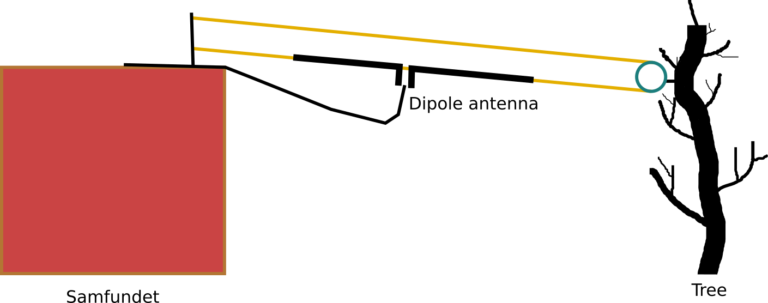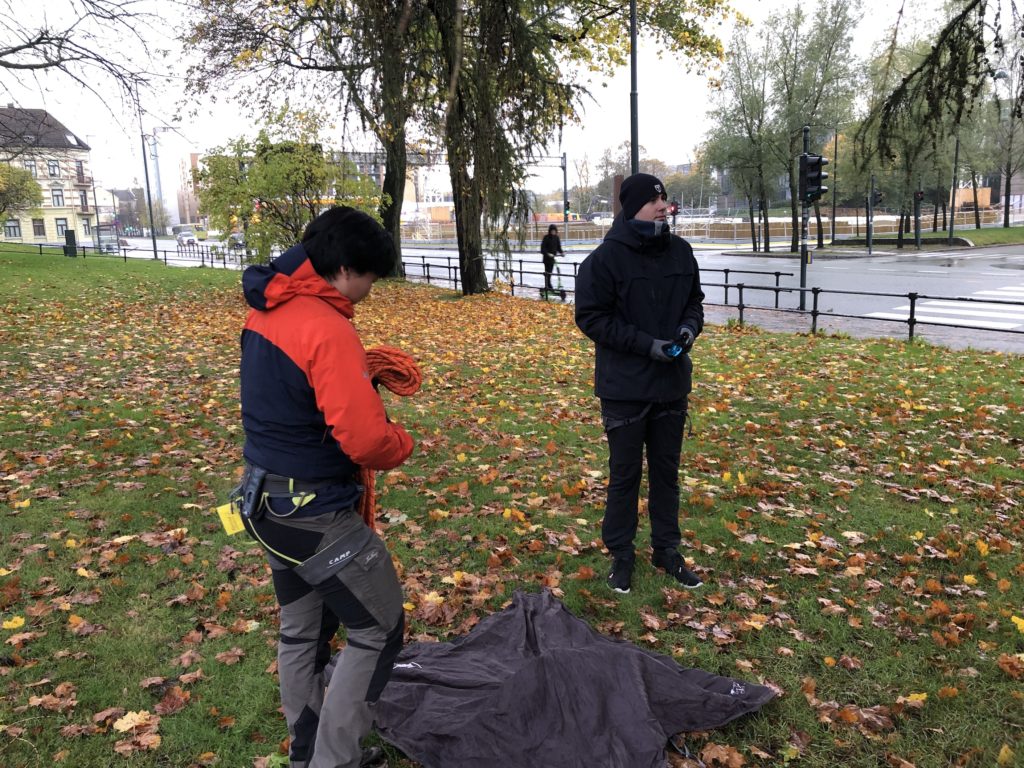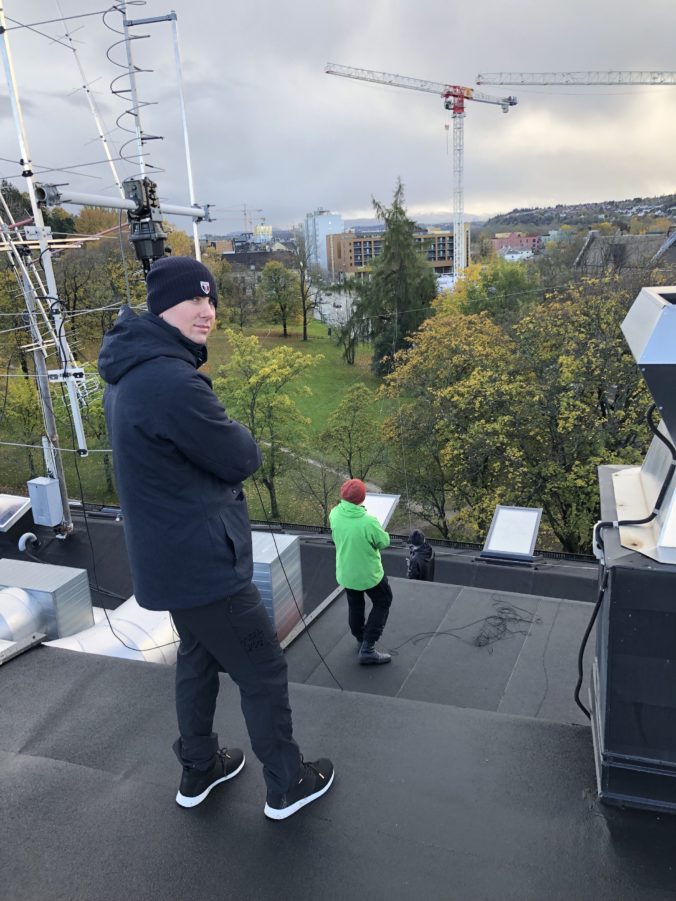By the fall of 2018, it was time to replace the ropes supporting our 160 m wire dipole. The flag lines had then been hanging in direct sunlight and feeling the force of nature since 2011. After we took the antenna down, some equipment was bought but the progress stalled and was pushed back. Now 3 years later, with new roofing at top of Samfundet all set and done, LB5DH and LB5PI were eager to get the band hooked up again.

From left: LB1DJ, LB5PI, LB1CJ and Jakob.
Photo: LB5DH
The plan was to replicate the solution we used on our 80m antenna in 2018 which allows for replacing the rope supporting the antenna without having to lower the antenna. This makes future maintenance and adjustments easier since we can replace the rope without having to re-climb the trees for replacements and adjustments. The antenna we were about to put up was our old 160m antenna with the “new” balun we prepared in 2018. It is an HF choke balun, but specifically made for 80m and 160m. To support it we acquired 200m 3mm Mastrant-M rope, which is more than enough, but the extra length proved to be useful during the installation.

The trick is to have a pulley in the tree which allows the rope through even with a knot. Then we can pull the replacement rope into position using the old rope. We can do this without lowering any part of the antenna since the other end is easily accessible, safely from the roof.

Photo: LB5PI
On Sunday morning at 9.00, after three weeks of planning, we met up to finally install the dipole. A great part of the work needed was to climb to the top of the 15-20 m high tree (courtesy of Google Earth’s elevation tool) to mount the pulley. The tree is not easily climbable, but with a ladder to help us off ground and our experienced climber, LB1CJ, we had high hopes.
We would have begun a week earlier, but unfortunately the rope was delayed in the international mail. Meanwhile we figured out the chain used to tie the pulley to the tree was ever so slightly too big for the tube brought in to stop the wear from the chain on the tree, so we had a nice tug-o-war in the hallway outside ARK to get it done.

Jakob is in the other end of the orange rope and LB1DJ is keeping the ladder stable.
Photo: LB5DH
Due to the possible negative health hazard of falling down a tree several stories high, we did take safety measures into consideration. LB1CJ tied safe supports to the branches as he climbed. Those held the rope that Jakob used to secure LB1CJ during the ascent.

Photo: LB5PI
The equipment LB1CJ carried to the top of the tree was the pulley and a chain to fasten the pulley to the tree.

Photo: LB1CJ
Due to a battery charger operator failure we ended up with only one 2m radio halfway through, which was of course not enough. In the beginning, shouting between tree and ground worked decently, but once the traffic caught up to us, it became an unbearable challenge. We therefore had to rely on commercial 1-to-1 duplex UHF networked digital radios (also known as cellphones) for the communication which turned out to be very impractical.

From left: LB1DJ, LB5DH and LB5PI.
Photo: LB1CJ
While LB1CJ was climbing up, the rest of us laid out the rope that would be used to support the antenna. We’ve had a placeholder rope in the tree since 2018, which we used to pull the new rope over the road, using the trees as temporary support. Then LB1CJ treaded the loose end of the new rope through the pulley and threw it down again. Finally, we had to pull the short rope end and the coax cable back up on the roof using the trees and the long rope end.

Photo: LB5PI
The tree work was all done at this point, and we moved on to the top of Samfundet to securely fasten the ropes. This was easier said than done, as the trees across the road was giving us a hard time shaking the rope loose, but luckily for us they eventually caved in.

With: LB5PI, Jakob L., LB5DH
Photo: LB1DJ
Yet another problem was waiting for us after getting the ropes and coax loose, and that was getting them untangled from each other. We pulled them as close as we could to try and spot how we should move ourselves to undo the knot, but it turned out to be a bigger challenge than anticipated, and we used some time trying to solve the puzzle. After squinting our eyes against the sunlight for a while and moving around, eventually the ropes split and we could finally begin tightening everything in place. A pair of binoculars probably would have helped us seeing the tangle better in retrospect.

Photo: LB5PI
The concluding parts went more smoothly. A second pair of pulleys higher up in the HF-mast kept both the ends of the new rope fully tightened. While pulling the ropes as close as we could, we also tried to keep the dipole as centered as possible. With the dipole itself being a 160 meter antenna, the optimal elevation above the ground should have been 80 m, instead of the 5-10 m we are at now. Not much we can do about the height of Samfundet or the tree (at least for now).

With: Brage, Jakob and LB5DH
Photo: LB5PI
With the antenna safely secured in its position, it was time to measure the SWR. We found that the dip was in the lower end of the band and that it was too narrow to cover the whole band. However, the bandplan states that the lower part (up to 1840 kHz) of the band is for CW and narrow band modes, which typically receives less interest than SSB at ARK. The Norwegian band regulations also limit TX power to max 10 W above 1850 kHz. We are therefore quite content with the dip of the antenna as it is close to the 10 kHz wide interval where we can run SSB at 1 kW TX power.

With: Jakob, LB5DH, LB1DJ and Brage
Photo: LB5PI
Last but not least, securing the coax…

Photo: LB5DH
…and, the finished product!

Photo: LB5DH
Thanks to Diversegjengen (DG) for lending us the ladder, and 73 from LB1CJ, LB1DJ, LB5DH, LB5PI, Brage and Jakob. You’ll hear us on the 160 meter band!


0 Comments
1 Pingback